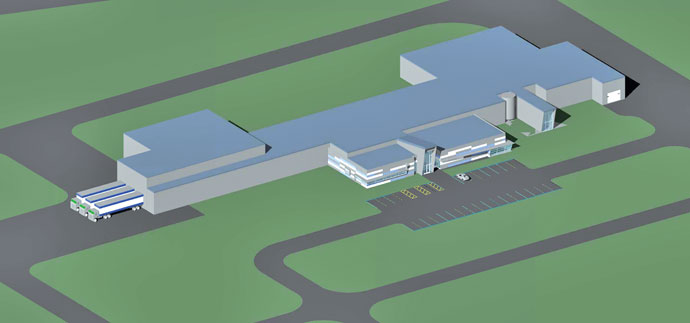Alpina Foods’ new dairy manufacturing plant in Batavia, N.Y., isn’t built yet, and already it’s been expanded — twice. When Genesee County Economic Development Center (GCEDC) announced the project April 8 with Alpina executives and a host of state, regional and local officials on hand, the plan was to build a 28,000-sq.-ft. (2,600-sq.-m.) dairy manufacturing plant for the production of the company’s ReStart zero-percent-fat yogurt.
Today, the plan is to build a 40,000-sq.-ft. (3,700-sq.-m.) plant at the Genesee Valley Agri-Business Park site, and two more additions are planned in the next five years that will boost the footprint to 65,000 sq. ft. (6,000 sq. m.) and then to 155,000 sq. ft. (14,400 sq. m.). About 50 new jobs will be created when operations commence, and more will follow as the operation expands.
The western New York project is Alpina’s first production foray into the U.S.; it operates nine industrial facilities in Colombia, Venezuela and Ecuador and has a commercial presence in several other countries. “Everything we do in Batavia will be geared to the mainstream U.S. market, not just the Hispanic market,” says Carlos Ramirez, managing director of Alpina Foods LLC. The company will launch additional products from the plant, including an energy smoothie.
Initial location analysis pointed to southeastern Pennsylvania as the location of choice, says Ramirez. “We then added other variables to the analysis, including skilled labor, milk supply, proximity to airports and local universities — the latter because we are very interested in collaborating with them on developing new products.” The final choice came down to sites in Scranton, Pa., where Alpina had access to Penn State, and the Batavia location, where Cornell University’s College of Agriculture and Life Sciences factored in. Cornell worked closely with GCEDC on luring Alpina to Batavia, but incentives tipped the scale in Genesee County’s favor.
“In that regard, Batavia was very, very aggressive,” says Ramirez, adding that the state, energy company and the 200-acre (81-hectare) Agri-Business Park played important roles, too, with tax rebates and incentives that come to approximately 25 percent of Alpina’s investment. Competing locations could not be as aggressive.
“New York was also offering the skilled labor we needed,” says Ramirez. “Pennsylvania may have had more available workers, but a lot of the workers around Batavia have dairy expertise and everyone knows about the business, which is very important to us.”
Alpina won’t limit its U.S. operations to western New York, says Ramirez. The company plans a southeastern U.S. facility next to help service the East Coast, followed by operations in the Southwest and West. “At some point, transporting milk and yogurt around the country gets very expensive, so it makes more sense to have additional facilities a few years down the road, when the expansions are complete at the Batavia location.”
Site Ingredients in 2011
It comes as no surprise to one key site consultant that the main driver of Alpina Foods’ expansion strategy in the United States is logistics. Michael Mullis, president and CEO of Memphis-based J.M. Mullis, Inc., says logistics is the number one factor in food-processing projects today.

“Logistics analysis is critically important, because of increasing fuel prices, both truck and rail, and in bringing in raw materials from other parts of the world by barge or through a deepwater port,” says Mullis, who has worked recently on projects for Dean Foods, Mars and Smuckers, among others.
The next consideration tends to be utilities, particularly with respect to water, wastewater and electricity, he relates. “These are all critically important in food processing. If you can get through those hurdles, then you move on to labor, where the requirements are above the level of many manufacturing operations. Food processing operations need labor with technical aptitude, computer skills and great dexterity. Many times, locations we are looking at will fall out of the running because of that.” Another labor consideration, says Mullis, is the round-the-clock nature of many food operations. “Even in this economy, it can be difficult to staff some of those shifts,” he says.
The fourth characteristic of today’s food processing project is its capital-intensive nature, Mullis points out. “The packages put together by whichever government entity or country become critically important.” Mullis’ firm was evaluating packages from seven countries at press time. “Packages generated today are measured on usually no more than five-year net present values, where it used to be 20-year and then 10-year then five- then three-year NPVs. Companies today are making their decisions predicated on what the net present value is on a very short period of time.”
Mullis relates a conversation he had with one state economic development office recently in the Southeast, in which he had to explain why that state’s tax credits would not be important to his client. “They’re not important to some companies because of their financial structures.” Most of the manufacturing operations are pass-through operations, with minimal in-state sales, and “tax credits of $20 million or $30 million don’t offer a great benefit financially.”
The healthiest sector of the food processing business today, says Mullis, is the distribution niche serving the low- to mid-scale restaurant chains, thanks to an economy that discourages higher-end dining. “Those companies can’t build facilities fast enough.”
